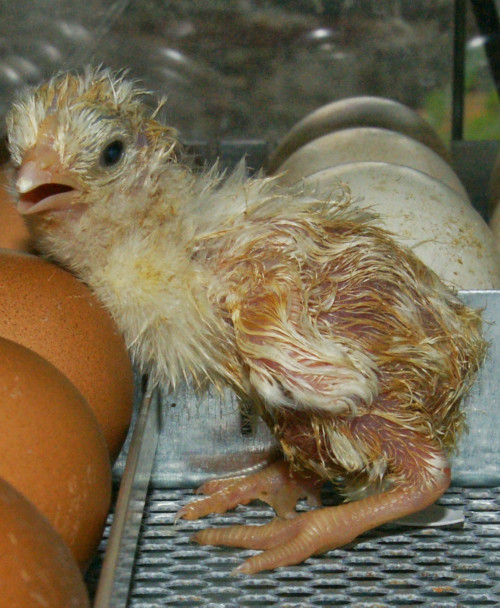Omphalitis or mushy chick disease and how to prevent and treat it.

Omphalitis is an inflammation of the navel or umbilicus and is also called yolk sack infection or mushy chick disease.
Table of Contents
Omphalitis or mushy chick disease is a bacterial infection of the yolk sac or navel in young chicks. Rough unhealed or incomplete absorption of the yolk sac leads to bacterial infection.
When the chick hatches the remaining unused yolk material is drawn into the abdomen and the body will close in around it.
The yolk sac provides vital nutrients and antibodies to the birds during incubation and the first few days of life. It is also good source of bacterial growth.
What does mushy chick disease look like?
The yolk sac is distended and has prominent blood vessels and is filled with abnormal brown, watery contents. The area around the yolk sac can be visibly swollen and the chicks exhibit symptoms of illness.
Below: Omphalitis and yolk sac infection in a day old leghorn chick. Navels are inflamed and yolk sacs are distended with abnormal contents. You can see the inflammation nearly touching the floor.

Faecal contamination of the egg shell and unsanitary conditions in the hatchery are considered the most important sources of infection. Bacteria may be acquired in Ovo, or via the egg, if the hen has salpingitis or via contamination following artificial insemination.
How common is Omphalitis or mushy chick disease?
Omphalitis or mushy chick disease affects between 0.3% and 6% of laying chicks.
The incidence of chicks with Omphalitis and yolk sac infection increases after hatching and decline by day six although occasionally losses can occur up to several weeks of age.
Consequences of Omphalitis and yolk sac infection can be severe. Infection can result in the deprivation of nutrients and maternal antibodies with resultant immunosuppression.
Chicks that survive are often stunned and do poorly in general. The absorption of toxin and systemic spread of E. coli may ultimately result in death.
Is mushy disease is contagious?
Omphalitis or mushy chick disease is an infectious but non contagious disease associated with poor regulation of incubation temperature or humidity and marked contamination of the hatching eggs or incubator with infectious agents.
It is not contagious and healthy chicks can not catch mushy chick disease from infected chicks.
The strains of bacteria that cause mushy chick disease are very infectious and can spread to humans as well.
What causes Omphalitis or mushy chick disease?
Escherichia coli (E. coli) bacteria is the most isolated pathogen but several different bacteria including Pseudomonas, Staphylococcus, Streptococcus and Clostridium are also involved in yolk sac infection. 70% of chicks with “mushy chick disease” had E. coli in their yolk sacs.
Other types of bacteria also can cause Omphalitis, although E. coli is most common. E. coli and Enterococcus faecalis infections accounted for approximately half of the mortality that occurred in layer chicks during the first week after hatching.
First week mortality was significantly correlated with total mortality in the flock but not flock uniformity. A variety of E. coli genotypes indicated different sources of infection. For good flock performance, first week mortality needs to be less than 1%.
Omphalitis symptoms:
The symptoms and clinical signs of mushy chick disease include:
- Affected birds are off feed and water.
- Chicks may be slow or inactive.
- Birds huddle near heat.
- Swelling, oedema, redness, and possibly small abscesses characterise acute inflammation of the navel.
- The abdomen is often distended, and blood vessels are swollen.
- In severe cases, the body wall and overlying skin breakdown and are wet and dirty, leading to the term “mushy” chicks.
- The yolk sac is typically distended because yolk has not been absorbed and inflammatory products have been added.
- Yolk is abnormal in colour, consistency, and smell, and may contain visible pus.
- Blood vessels of the yolk sac are often prominent.
- Chicks with infected yolk sacs that live more than 4 days also may have peritonitis, pericarditis, or perihepatitis, indicating local and systemic spread of the organism from the yolk sac.
How do you treat Omphalitis in chicks?
Optimal hatching and brooding conditions are fundamental in reducing the overall impact of Omphalitis and yolk sac infection.
Specific treatment is limited and most interventions are supportive to improve the conditions and treat the symptoms of the disease.
Omphalitis is treated by:
- Giving multivitamins and electrolytes in the water.
- Improving the ventilation of shed or brooder.
- Antibiotics for 3 to 10 days as prescribed.
- Replacing floor covering with dry material.
- Consult a Veterinarian for other supportive treatments.
- Culling and starting over.
Badly infected birds may never recover fully even if they survive.
Prevention of Omphalitis in chicks?
As with so many things in poultry keeping, prevention is better and cheaper than cure.
Steps that can be taken to control Omphalitis include:
- Careful regulation of the environment through management of feed, water, temperature, litter and lighting.
- Not setting dirty or floor eggs.
- Removing damaged, cracked or clear eggs from the incubator.
- Ventilation is important.
- Low brooding temperatures and fasting after hatching, can increase the incidence of infection and mortality.
- The incubator should be cleaned and disinfected thoroughly between hatches. If fumigation is to be done with formaldehyde then follow the manufacturers instructions.
- Omphalitis can be exacerbated by poor brooding conditions; ensuring litter is sufficiently warmed before chick placement is key.
Can a chick survive omphalitis?
Under the right conditions and with supportive treatment chicks can survive Omphalitis.
The real question is whether you would want them to. Chicks that survive are likely to be carriers of salmonella or E. coli and are likely to be unthrifty and slow growing.
Factor influencing the susceptibility to Omphalitis include poor hygiene and incubation practise as well as the setting of poorly chosen eggs.
